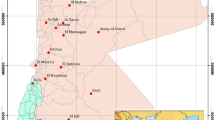Abstract
The Kingston Basin in Jamaica is an important hydrologic basin in terms of both domestic and industrial sector. The Kingston hydrologic basin covers an area of approximately 258 km2 of which 111 km2 underlain by an alluvium aquifer, 34 km2 by a limestone aquifer and the remainder underlain by low permeability rocks with insignificant groundwater resources. Rapid development in recent years has led to an increased demand for water, which is increasingly being fulfilled by groundwater abstraction. A detailed knowledge of the water quality can enhance understanding of the hydrochemical system, promoting sustainable development and effective management of groundwater resources. To achieve this, a hydrochemical investigation was carried out in the Kingston Basin. Results showed that the water is Na–Ca–Cl–HCO3 and Na–Ca–HCO3 type with higher concentrations of nitrate, sodium and chloride as the leading causes of contamination in most of the wells. High concentrations of nitrate correlate with wells from areas of high population density and could be attributed to anthropogenic causes, mainly involving improper sewage treatment methodologies or leaking sewer lines. Jamaica, owing to its island nature, has the continuous problem of saline water intrusion, and this is reflected in the higher levels of chloride, sodium and conductivity in the water samples collected from the wells. The wells studied show higher concentrations of chloride ranging from around 10.2 mg/l in wells located approximately (4931.45 m) from the coast to around 234 mg/l in the well located near to the coast. The conductivity values also closely correlate with the chloride levels found in the wells.









Similar content being viewed by others
References
Alexakis D (2002) The impact of geologic and anthropogenic factors on the quality and the chemical composition of East Attica groundwater’s. Ph.D. Thesis, National and Kapodistrian University of Athens (in Greek with English abstract)
Alexakis D, Kelepertsis A (1998) The relationship between the chemical composition-quality of groundwater and the geological environment in the East Attiki area, Greece. Mineral Wealth Australia. Hydrogeol J 5(4):71–88
Chubb LJ (1958) Higher Miocene rocks of Southeast Jamaica. J Geol Soc Jam 102:26–31
Eugstar HP (1970) Chemistry and origin of the brines of Lake Magadi Kenya. Miner Soc Am 3:213–235
Fernandex B (1996) Groundwater quality assessment of the Liguanea plains sub-basin. Report underground water authority, Jamaica, pp 40
Fernandez B (1982) The pollution of Jamaica’s groundwater resources—an islandwide overview by basins. Report Water Resources Authority, pp 38
Hem J (1985) Study and interpretation of the chemical characteristics of natural waters, 3rd edn. U.S. Geological Survey, water supply, paper 2,254, Washington DC
Jankowski J, Acworth RI (1997) Impact of debris-flow deposits on hydrogeochemical processes and the development of dryland salinity in the Yass River catchment, New South Wales, Australia. Hydrogeol J 5(4):71–88
Jones BF, Eugstar HP, Retting SL (1977) Hydrochemistry of the Lake Magadi Basin, Kenya. Geochim Cosmochim Acta 41(1):53–72
Kelepertsis A (2007) Geochemistry. Symmetry, Athens, Greece
Pachero J, Marin L, Cabrera A, Steinich B, Escolero O (2001) Nitrate temporal and spatial patterns in 12 water-supply wells, Yucatan, Mexico. Environ Geol 40:708–715
Piper AM (1944) A graphical procedure in the geochemical interpretation of water-analysis. Trans Am Geophys Union 914:914–928
Robinson E (1969) Geological field guide to Neogene sections of Jamaica. J Geol Soc Jam 10:1–24
Sami K (1992) Recharge mechanisms and geochemical processes in a semi-arid sedimentary basin, Eastern Cape, South Africa. J Hydrol 139:27–48
Statistical Institute of Jamaica (STATIN) Population Census 2001, Vol 1, part 2, Parish of St. Andrew, pp viii–ix
Todd D (1980) Quality of groundwater, In: Groundwater hydrology. Prentece Hall Inc., London
Wen XH, Wu YQ, Wu J (2008) Hydrochemical characteristics of groundwater in the Zhangye Basin, Northwester China. Environ Geol 55:1713–1724
Wright E (1990) Ferry Springs Utilization Project. Report. Ministry of Public Utilities, Underground water authority, Jamaica, pp 27
Acknowledgments
The authors greatly acknowledge the assistance offered by the Water Resources Authority and National Water Commission of Jamaica for assisting us with the sample collection, Chemistry Department at UWI Mona, Mona Geoinformatix Ltd, Mines and Geology Division, Ministry of Energy, Mining & Telecommunication, in sample analysis and production of population density map of Kingston.
Author information
Authors and Affiliations
Corresponding author
Additional information
An erratum to this article is available at http://dx.doi.org/10.1007/s12665-015-4297-7.
Rights and permissions
About this article
Cite this article
Mandal, A., Haiduk, A. Hydrochemical characteristics of groundwater in the Kingston Basin, Kingston, Jamaica. Environ Earth Sci 63, 415–424 (2011). https://doi.org/10.1007/s12665-010-0835-5
Received:
Accepted:
Published:
Issue Date:
DOI: https://doi.org/10.1007/s12665-010-0835-5




